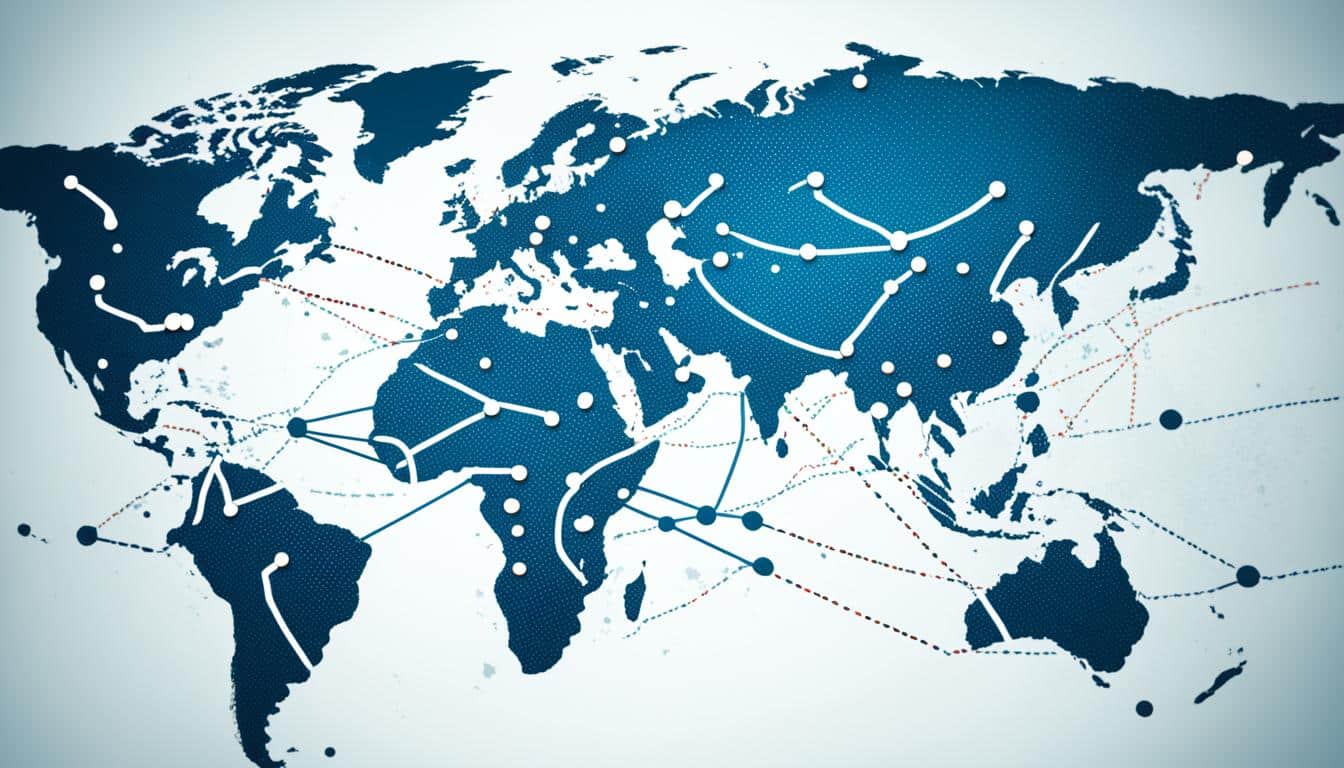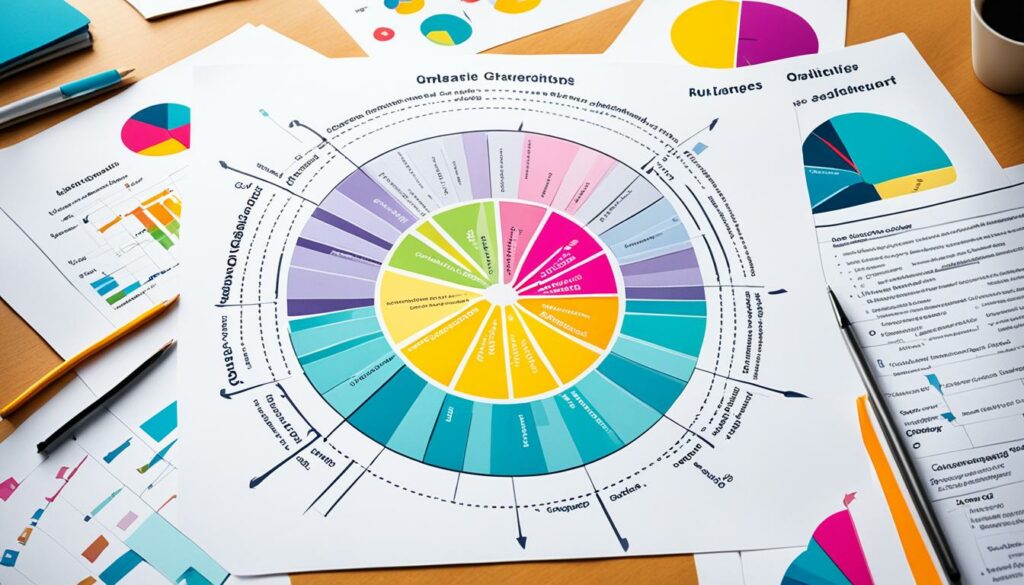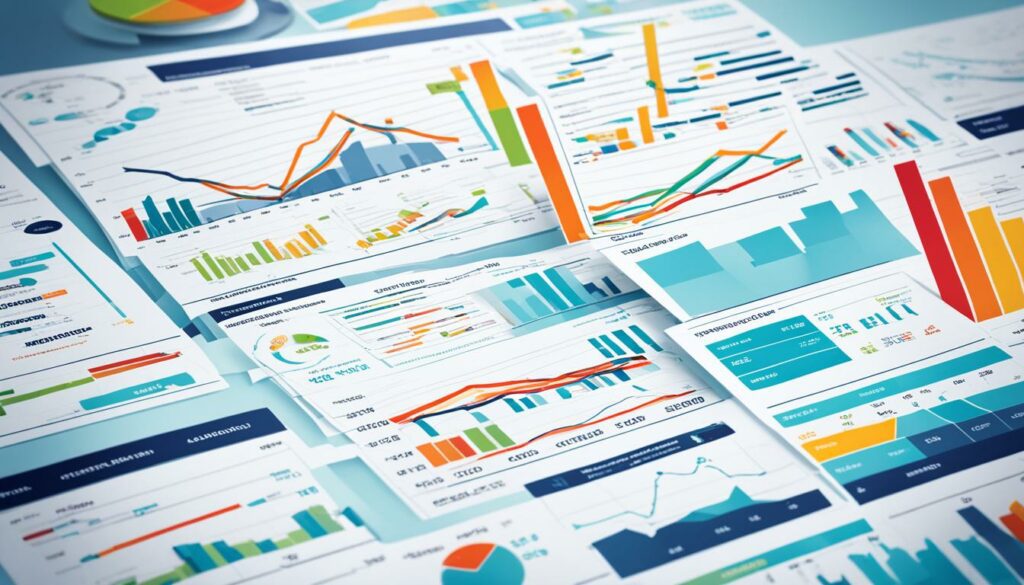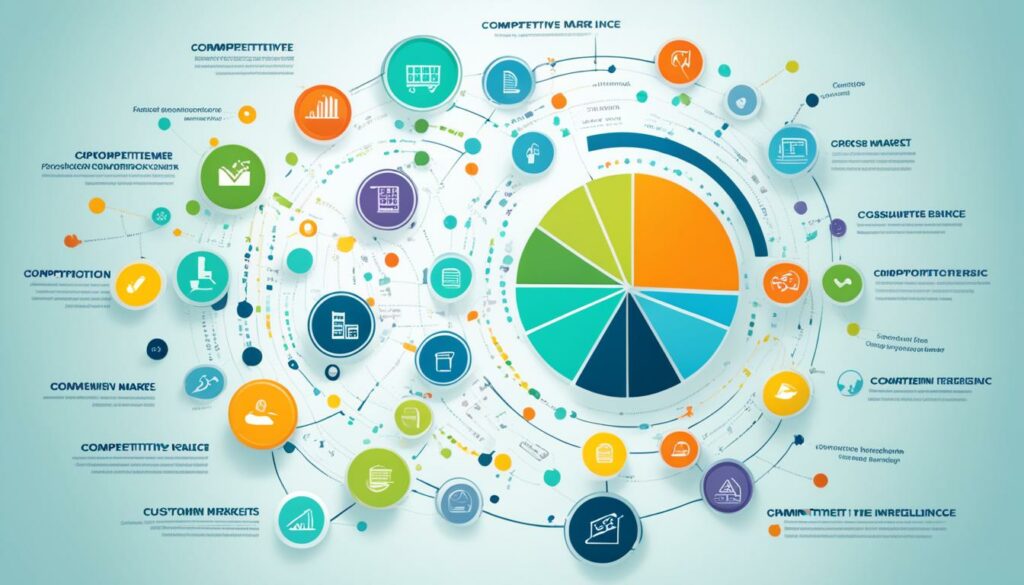Menu

In 2017, the United States sent 48 million kilograms of Canadian soybean seed to other places. This was valued at $28 million. The figures highlight the need for deep export market studies. As companies look into worldwide trading, learning about market desires and different export spots is key.
Getting tips from the pros and reading unbiased reports are ways to steer export strategies right. This approach helps save money and time. It is about choosing the best export paths carefully.
For pulling off a win in the global market, expert analysis is essential. By looking at sales numbers and reports, you get the big picture of the market. By comparing what the U.S. sells with what others buy, companies here can figure out what makes them stand out and where they can fit in.
Both basic and in-depth checks on the market are needed to make smart choices. This mix of research pulls together facts for good planning. It’s all about using what you’ve learned to grow your export game and focus on the markets that hold the most promise.
Export market analysis helps businesses study international markets. It guides them in making wise export plans. This method is vital for a good look at market conditions. It lets companies spot chances and avoid potential risks.
Export market analysis looks at many factors in a market. It considers market demand, who the competitors are, and any rules to follow. The value of this type of analysis is huge. It helps firms know if entering a new market is smart and if it would be profitable.
Analyzing an international market has several parts. It includes:
Thorough international market analysis benefits exporters in many ways:
Conclusively, detailed market analysis is critical for export success. It helps exporters plan well, setting them up for a better position in international trade.
It’s key for companies wanting to grow internationally to know the methods for export market analysis. Each method offers different but valuable information. This helps businesses make informed choices. The main methods are quantitative analysis, qualitative analysis, and a hybrid market analysis methodology.

Quantitative analysis uses numbers to spot trends. For example, there are 90 million service jobs in the U.S., making almost 80% of GDP. This kind of data is vital for understanding market size and impact.
In fields like travel, $256 billion in exports underlines the use of numbers in analysis.
Qualitative analysis looks at what drives customers, like their likes and dislikes. For instance, the U.S. film and music industry thrives globally by knowing what movies and songs people like. This influences how they create and promote their content.
Education also benefits. Knowing the potential in overseas markets helps schools create interesting courses.
A hybrid market analysis methodology mixes both numbers and stories. It gives a full picture. The growing e-business sector, set to see more success with 600 million internet users, shows the power of this approach.
It helps understand market size and also the unique needs of people.
| Methodology | Focus Area | Example Sector |
|---|---|---|
| Quantitative Analysis | Statistical Data | Travel and Tourism |
| Qualitative Analysis | Consumer Behaviour | Film and Music Entertainment |
| Hybrid Market Analysis Methodology | Combined Insights | E-business |
Using these methods leads businesses into global markets wisely. They open doors for growth, from environmental technologies to finance. With this combined strategy, choices become smarter, based on solid facts and understanding people’s needs.
Having the right market intelligence is key when you’re exploring global markets. Businesses can use many different market intelligence resources to find insights. These insights help make important strategic decisions.
When doing global market research, you need a mix of tools. Primary research is hands-on, like interviews and surveys. Though it takes time and money, it gives you data specific to a particular place.
Secondary research is more affordable and comes from trade stats and reports. This type covers broader trends but is still very useful.
Import stats show what products different countries buy. They can point out new, high-demand markets. U.S. export stats, on the other hand, tell us where American products go. This lets us spot market trends and plan our strategies.
Getting advice from experts can really improve your market know-how. They look at a market’s growth, its competition, and what people are buying. They also consider important trade agreements.
Personal market research, like talking to people in the target market, gives unique, spot-on data. Yet, it’s usually time-consuming. Secondary research, in contrast, covers general info such as how big a market is or how much money people make. This gives a full picture of a market’s potential.
Research focused on countries or industries can be very targeted. It tells us about the economy, politics, and culture of a place. This helps businesses decide where and how to get involved.
| Research Type | Cost | Data Source |
|---|---|---|
| Primary Market Research | High | Surveys, Interviews, Direct Contacts |
| Secondary Market Research | Low to Free | Trade Statistics, Industry Reports |
| Foreign Import Statistics | Varies | National Trade Databases |
| U.S. Export Statistics | Varies | U.S. Government Agencies |
The Country Commercial Guides (CCGs) are essential for companies wanting to do business in other countries. They cover over 100 nations with details on market conditions, opportunities, and important rules. This information is key for creating successful plans to export or expand internationally.

Each CCG dives deeply into a country’s market. It looks at what people can afford, what they like, and how products get to them. By knowing these details, companies can match their offerings to what local people want. CCGs are made by experts in U.S. embassies, making them accurate and useful.
CCGs help spot the top areas for U.S. businesses to export to or invest in. They also help firms understand a country’s trade rules, customs, and quality standards. Knowing this can prevent expensive mistakes and help companies follow the rules smoothly.
Using the CCGs well can really boost a company’s success worldwide. They touch on Doing Business, Political and Economic Environment, and more. The guides use the latest information from the U.S. Commercial Service’s Market Research Library too. This library has over 100,000 reports, making the CCGs even more valuable.
In global trade, doing research on your industry-specific export research is vital. It gives businesses a deep look into their field. This lets them find special chances and deal with problems better. It’s key to do thorough sector-specific market analysis. It helps in learning how the market works and in making solid export plans.
To win at exports, a company must look closely at different international markets. Small companies should look at 3 to 5 markets, to put their efforts where they count the most. Knowing the difference between direct (the primary) and indirect (the secondary) market research is also very important.
Adding U.S. export stats to foreign import data makes market analysis more precise. It can show you big market trends, who your rivals are, and where you should focus. Looking at data about the people, their incomes, and what industries are strong in a place can also be a big help.
It’s crucial to make an export plan based on detailed research. This plan should use info on market trends, who your competitors are, and any trade deals out there. Focusing on a few target countries makes sure you use your marketing money well. Growing a global business takes long-term planning and a lot of dedication.
The U.S. Commercial Service has Country Commercial Guides that are full of helpful market info. These, along with direct market research, can help businesses make smart choices. While doing direct research can be expensive, using info that’s already out there can save money.
To wrap up, using research specific to your industry is key for businesses wanting to win in global markets. Doing in-depth market analysis lets companies lead in spotting and using market trends. It puts them in a strong place in the worldwide trade.
Knowing and using the newest market trends is key for exporters who want to be competitive. By regularly looking at the recent market trends analysis, companies can plan ahead. They can change how they work based on what consumers want, new technologies, and the economy.

It’s important to look at export numbers from the USA and import numbers from abroad to get a full market picture. This helps spot what people want, find good markets for U.S. goods, and understand market conditions. State export data can show where products do well. It also helps in setting prices smartly.
Finding out what’s new by talking to buyers and using surveys is a big help. So is checking out trade data and reports. This mix gives a complete view of market dynamics monitoring.
It’s smart to pick three to five markets to look at closely, then choose the best one to start with. This lets smaller businesses use their resources well. They can enter new markets one by one.
| Research Type | Description | Benefits |
|---|---|---|
| Primary Market Research | Involves direct contact with buyers through interviews and surveys. | Provides first-hand insights and immediate feedback from the market. |
| Secondary Market Research | Uses trade statistics and reports from third-party sources. | Cost-effective and offers broad data that is sometimes free. |
Market segmentation is vital for businesses looking to improve their marketing. It helps them reach out to specific groups of consumers. By focusing their efforts, companies can boost loyalty and stand out against competition.
Market segments are like smaller groups within a larger market. They include people with similar needs or traits. Segmentation types can range from age and location to how people use products.
After knowing the segments, businesses must plan how to reach them. Effective strategies include concentrating efforts on the most promising segments. Bain & Company states well-focused strategies lead to better profits.
The aim is to stand out in several ways:
Good segmenting and targeting offer many advantages to businesses:
| Strategy | Benefit |
|---|---|
| Targeted Digital Advertising | Enhanced response rates with lower acquisition costs. |
| Stronger Marketing Messages | Personalised messages tailored to specific consumer groups. |
| Increased Brand Loyalty | Attracting and retaining the right customers through relevant engagement. |
These strategies can set companies apart, draw in specific markets, and boost their success. By deeply understanding consumer needs, businesses can meet those demands better.
In today’s fast-changing world market, knowing your competition is key to export success. By studying what your rivals are doing and the general market, you can make strong plans. These plans should use what makes your products unique.

To understand what your competitors are up to, look closely at them. This means checking out their strategies, what they’re good at, what they’re not so good at, and what they’re selling. You should also look at how much they’re charging, where you can buy their stuff, and how they’re advertising.
If you look really hard, you’ll find tips on how your business can stand out. Plus, you might spot chances where your competitors have left openings you can make the most of.
Having an edge over your rivals means knowing what’s special about what you’re selling. Modern tech lets you sift through lots of info to find the gems. Meanwhile, keeping an eye on social media and what your customers are saying can give you instant clues about what they like and what’s hot in the market.
Putting your market smarts to good use means making changes where they’re needed. This could mean making your ads better, tweaking how much you charge, creating new products, or finding different ways to get your stuff out there. Keep an eye on what’s new, and adjust your plans quickly. This way, you’ll stay ahead in a market that’s always changing.
Free Trade Agreements (FTAs) help exporters a lot. They lower taxes and make it easier to sell in new markets. These agreements are key for helping businesses sell more abroad. They help fight the tough competition in other countries.
The United States works with 20 countries on FTAs. This opens up new chances for companies. The USMCA deal is a good example. It helps industries like electronics, medicine, and farming. With USMCA, bringing in clothes is cheaper than it was before.
FTAs are more than just tax breaks. They give smart ways to manage how goods move. The U.S. has deals with places like Australia and Chile. It works with groups, too, like CAFTA-DR. These all help companies get bigger around the world.
Today, there’s software to help manage FTAs better. ONESOURCE Free Trade Agreement Management makes things smoother. It knows the rules, tracks products, and does paperwork fast. This cuts down on errors and saves time.
Even though FTAs are great, not all companies use them well. Learning about the rules and using them right can help a lot. It makes companies stronger in the world market.
Export data helps us spot growing markets and use trade numbers smartly. It’s key for businesses to look at different trade signs and know their effects. This helps them choose the best path for global growth.
Good trade data sources are a must for spot-on analysis. Platforms like Trade Stats Express are great for U.S. export info. Using these tools gives a broad look at market trends, making analysis stronger.

Trade Stats Express is great for understanding export data. It looks at past trade, which is very important. This tool helps to see where export growth could happen by checking things like import trends and GDP growth. It’s a key way to get the right numbers.
To find growing markets, you need to look at lots of signs, often by product and where it’s going. For instance, tracking trade growth shows what might change in U.S. exports. A deep look at these signs lets businesses find the best markets for growth and expansion.
Here’s a look at key export indicators:
| Indicator | Description | Weight |
|---|---|---|
| Historic Trade | Looks at past trade’s success, very important | 50% |
| Potential Trade Growth | Guesses changes in export based on import and GDP growth | Variable |
| Maximum Average Tariff | The average tax on a product code | Crucial |
Using these trade stats well shows my skill to spot new international markets. It helps make smart choices for growth.
For a more in-depth look, check the tool on Trade Stats Express.
Market research is growing. It uses both soft and hard data. Soft data adds insights that hard data misses. Together, they give a clearer picture of the market.
It’s key to know what sets hard and soft data apart. Hard data is numbers from research. It tells us market sizes and growth. Soft data is from talking to people. This includes views from interviews and surveys. It helps us understand the meaning behind the numbers.
| Aspect | Hard Data | Soft Data |
|---|---|---|
| Source | Surveys, Reports | Interviews, Focus Groups |
| Nature | Quantitative | Qualitative |
| Usage | Statistical Analysis | Contextual Understanding |
| Example | Market Size | Consumer Preferences |
Qualitative research has many pluses. It helps us see the ‘why’ behind numbers. This is great in industries like Telecom and Retail. They need to feel the consumer’s pulse to do well.
The Big Data and Analytics field is growing fast. It’s big in North America and Europe. Using both soft and hard data is vital. It helps products do better and get to more people. So, blending soft and hard data is smart. It gives us a full view of the market.
In the world of international trade, a market analysis report is crucial. It’s key for businesses looking to enter new markets. These reports offer insights on where to enter, how to compete, and what customers want. They help develop strategies fit for each business.

Customised market research reports are great because they give specific data. They look at things like U.S. exports and another country’s imports. This helps spot new markets where there’s less competition. It makes the business’s efforts more effective.
These reports use both primary and secondary research. Primary research is detailed but costly and takes time. Secondary research is less expensive, using data that already exists. It’s a good way to get valuable insights without much cost.
Good market research covers many areas such as market profiles. This includes looking at economy, trade, and culture in potential new markets. Knowing this helps build a strong export strategy. It also helps to focus on markets that need the products your business sells.
Let’s look at the example of the Global Cosmetic Laser Market. It was worth USD 3.1 Billion in 2024 and might hit USD 11.6 Billion in 2033. These figures show how important tailored market insights are. They help companies adjust and improve their strategies based on trends.
Here is a table that shows the kind of data found in customised market research reports:
| Year | Global Cosmetic Laser Market Value (USD Billion) | Growth Rate (CAGR) | Market Share (%) |
|---|---|---|---|
| 2023 | 2.8 | – | – |
| 2024 | 3.1 | 14.7% | 75.3% (Ablative Lasers) |
| 2033 | 11.6 | 14.7% | – |
| 2021 | – | – | 15% Increase (Cosmetic Procedures) |
Customised market research reports are vital for businesses. They offer a roadmap for success in international markets. With a strategy based on exact market needs, companies can aim for long-term success globally.
Export market analysis is tough but crucial for international success. The hurdles can be anything from tricky market trends to lots of rules. To grow and stay ahead, businesses need to spot these challenges and work out ways to beat them.
The first step is finding out what the problems are. Doing thorough research on the export market is key. This means looking at things like how big the market is, its growth chances, who else is selling there, and the local culture.
Figuring out what people want to buy helps businesses to offer the right products. And studying other companies can show what works in terms of price and how they sell.
After pinpointing the issues, it’s time to tackle them head-on. Getting into a new market might mean dealing with strict rules, taxes, and more. It’s important to check the risks, like how stable the country is, its economy, and its laws, and then plan how to handle them.
Choosing who will sell the products and how they will market them is vital. Tailoring prices and ads to fit the new market can boost success chances.
Exporting is key for expanding for many businesses. Yet, it comes with its own set of tough challenges, especially for smaller firms.
Extra costs like import duties and tariffs could mean customers won’t buy as much. Meeting different quality standards around the world is a must to avoid delivery issues and keep a good name. Plus, currency rates that keep changing make pricing products a real puzzle.
Dealing with the rules to ship goods is detailed work and needs a sharp eye. But the rewards of exporting, like bringing in new income and growing, are big. Below is a table that gives tips on tackling some common hurdles:
| Challenge | Strategy |
|---|---|
| Market Entry Barriers | Conduct detailed market research and adapt entry strategies |
| Import Restrictions and Tariffs | Utilise Free Trade Agreements and negotiate terms |
| Quality Standards | Ensure compliance with local standards and certifications |
| Currency Exchange Rate Fluctuations | Implement dynamic pricing strategies |
| Complex Compliance and Documentation | Invest in specialised compliance expertise |
To achieve global trade success, a carefully planned approach is crucial. The series has shown us the value of knowing the industry well and using strong analysis. This means really getting to know U.S. export statistics and what other countries want. This way, companies can find the best markets for their products.
Small businesses should target a few key markets instead of trying to sell everywhere. This focused approach saves money and lets them focus better. They should look for markets that are growing steadily and welcome U.S. products. Also, places that have free trade agreements are good options.
Creating a solid export plan and sticking to it is key for long-term success. The time it takes to see profits in international trade can be long. So, being patient and sticking with the plan is important. Services like the Canadian Trade Commissioner Service and the Agri-Food Trade Service offer great advice and help.
Successful exporting is about more than numbers. It means understanding other cultures and building relationships with customers. It’s also about using market trends wisely. With these skills, exporters can do well in the global market. They can make smart choices that boost their export business.
Export market analysis looks into the demand and factors of export places. It’s key for companies to use their resources wisely. This includes finding chances in the market and developing the right export plans from the start.
Market size, segments, and who the competition is are the main parts. They give a full view of what the market is like. They help guide how to deal with laws and the competition.
By learning about the market and what consumers want, exporters find ways to shine. They can do better than their rivals by being smart about their choices. It helps them fit what’s needed in the market.
There are two main ways: one’s about numbers and trends, the other’s about what people think and feel. Both are needed to really understand the market.
Special reports and guides are a big help. They give deep insights into different markets. This helps in understanding rules and finding chances in each industry.
These guides give detailed info on different markets. They are made by experts in U.S. embassies. They are key in planning how to export well and match local needs.
Focusing on their field’s trends and changes helps exporters grow. It keeps them informed about what’s new and helps them stand out among competitors.
Staying updated on trends helps exporters prepare for what’s next. This knowledge means they can be ahead in planning. It’s a key way to stay strong in the market.
This is grouping markets based on common needs or traits. It lets companies direct their products and efforts where they matter most.
It’s learning all about rivals and the market. This helps companies use their strengths well. It makes sure they can serve customers in the best way and stand out.
FTAs offer less tax and easier entry into markets. Knowing about and using these agreements lets companies do well internationally. It’s a big help in places where barriers are few.
Trade data from places like Trade Stats Express shows where to grow. It points out trends and lets companies make smart choices. This is key in planning what to do in the market.
Hard data means facts and figures, while soft data is from opinion and feelings. Together, they paint a clear picture. This is crucial to understand what customers need and how the market changes.
These reports are made for each company’s needs. They cover things like how to get in a market or beat the competition. This kind of help is great in making a strong plan and acting on it.
It’s tough to understand all the laws and the market itself. Yet, facing these challenges with the right help and plans can lead to success. It’s all about being ready and flexible.